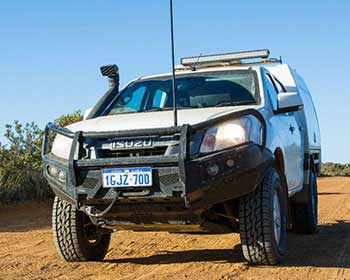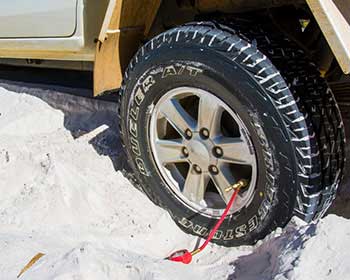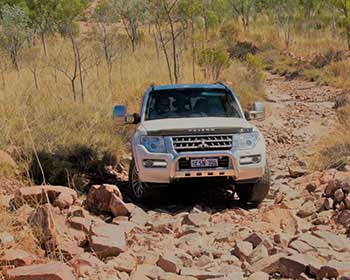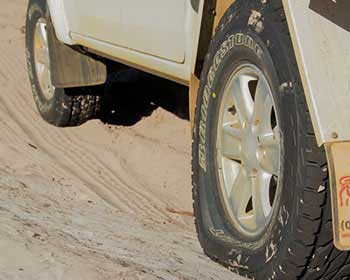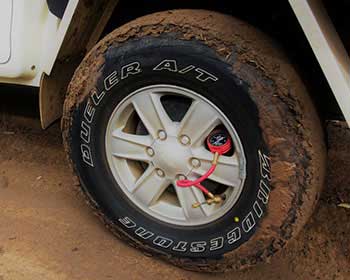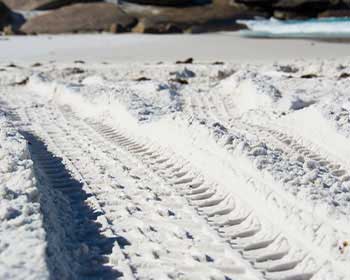5 things to know about 4WD tyre pressures
You might not have put much thought into the air pressure that you run in your 4x4 tyres, but you really should. The wrong tyre pressures can create all sort of issues. In this post, we take a look at 5 things you should know about 4x4 tyre pressure, and how it affects handling and safety.
1. Tyre pressures are critical for your safety
The only thing that makes contact with the ground on your 4x4 is four very small handprints of rubber at the bottom of each tyre (sometimes less than four wheels if you are off road!).
The pressure inside the tyre directly relates to how well that small surface area can make your 4x4 brake, steer and accelerate.
If you are running the wrong tyre pressures, your traction can be severely compromised, and that’s a big problem. Beyond this, tyre pressures that are too low can damage tyres and eventually lead to a failure, which isn’t something you want to experience. It’s expensive, dangerous and can leave you in a difficult situation.
Find out more about checking your tyre pressure.
2. 4x4 tyre pressures change often
Did you know that the pressure you put in your tyres doesn’t always stay the same when you pump them up? It actually changes, and often. Through your day to day braking, steering and acceleration, tyres create friction. They also flex up and down on the sidewalls, and this generates heat. With heat comes expansion and as a result tyre pressures increase. The colder the air inside the tyre, the lower the tyre pressure.
If you check your tyres after being parked up for a night, they might read 35 PSI. Hop in the 4x4, and drive for more than half an hour and check them again. There’s a pretty good chance that they will now read somewhere between 38 and 42 PSI, and that’s completely normal.
The lower your pressures and the more the tyre flexes, the more the tyre pressures will change. For example, driving on extreme corrugations will result in a lot of heat as the tyres’ sidewalls are constantly moving in and out. Tyre pressures are extremely critical, and if you don’t check them regularly you might find you are getting a false indication.
To give you an example, after several hours of bitumen driving on a trip, I arrived at the start of a gravel road. I jumped out, deflated the tyres down to 28 PSI, and proceeded on. The following cold morning, I thought I would check them again, and found them sitting at 22 PSI. That’s a substantial difference.
On a bitumen road, this constant changing of tyre pressures is less important, but once you head off road, it becomes a big factor. Most beach driving is done at around 16 – 20 PSI, and if your air pressure is going up or down by 4 – 6 PSI it can be the difference between comfortably driving down a beach and sinking to your chassis rails. It also affects the ride comfort, which is really important on rough roads, as higher pressures provide a harsher, bumpier ride.
Learn more about the Bridgestone Dueler 4x4 tyre range.
3. The right pressures protect your 4x4 when off road and make driving more comfortable
There are a number of good reasons for dropping the tyre pressures when you head off road, and we cover two more of those in points below. However, one of the most important reasons for removing air on rougher roads is that it provides a greater cushioning effect.
As the driver, or a passenger, you will notice tyre pressure adjustments. Corrugations which were bone jarring and jaw clattering become bearable, especially when paired with a suitable speed (that is both comfortable and safe!).
Beyond that though, if you feel more comfortable, so does your 4x4. Spare a thought for your suspension moving up and down thousands of times an hour, doing its best to reduce the force passed onto the vehicle itself. Your tyres do the same thing, helping to stop those nasty corrugations being passed upwards through your 4x4 and to the occupants and luggage. Every nut, bolt, bush and electrical connection takes a huge beating off road, and by lowering air tyre pressure you cushion and look after every part of your vehicle better.
I’ll never forget arriving at Manning Gorge on the Gibb River Road one afternoon to see two Toyota Prados with extensive damage. One had a factory aluminium bull bar in pieces, and they both had damage to various lights and other accessories. The common denominator? Neither owner had let any air out of their tyres, as they were advised not to. Most other people had let their tyres down, and had very little damage, if any at all. It makes a huge difference, and you will physically feel it after letting air out on rough roads.
4. Lower pressures reduce track damage
4x4ing should be done responsibly. This means leaving the area in the same way as you found it. Tearing up tracks is not good for anyone, and I’m not referring to intentionally doing so either. I’m referring to driving tracks without the right tyre pressures, which also causes extensive damage. The more you deflate your tyres, the greater footprint of rubber that touches the ground. This spreads the load, gives you more traction and results in less wheel spin.
Wheel spin is the enemy of track preservation, and by knocking a few PSI out of your tyres it makes a big difference. When you think of how many thousands of 4x4s do the same tracks each year, it’s no wonder taking the time to properly adjust your pressures is worthwhile.
Everyone should be doing their best to look after this amazing country, and keep it open for generations to enjoy. Doing your part is the right thing to do, and correctly adjusted tyre pressures are a good start.
5. It affects your traction and risk of punctures
Correct tyre pressures improve your traction and reduces the chances of getting punctures. When off road, traction is imperative for safety, reducing track damage and ultimately getting where you need to go. Traction is king. No matter what modifications your 4x4 has, if you don’t have traction to make the car move where you want it to, it’s all in vain.
When you reduce pressure, the sidewall is able to flex more, which distributes the weight of your 4x4 over a larger patch of ground, increasing your traction. This is especially important on sand, where highway pressures result in sinking to the chassis rails in a matter of seconds.
On rough roads, punctures can be a common and frustrating occurrence. This happens a lot on roads where the track is rough, but also normal gravel roads which have rocks that are sharp, and facing the wrong way.
By removing some air, it allows the tyres to mould around the sharper objects instead of popping when they come in contact. A lot of people refer to a balloon, which at half pressure can be touched against something sharp without too much of an issue. Pump it up all the way and do the same thing though, and the result is a big bang. Tyres behave in the same way.
Please note that as you lower tyre pressures, the sidewall bags out, and you expose more of it (which can increase the chances of a puncture to the sidewall), so it’s imperative you deflate enough, but not too much air from your tyres.
Tyre pressures are super critical
At the end of the day, your 4x4’s tyre pressures are probably the most important factor that you easily have within your control. They need to be correct for the bitumen based on your vehicles tyre size, type and weight. Once you leave the bitumen, you should be reducing them about 30% for rough corrugated roads, and even more for mud, sand and rock work, but this is at working, or hot tyre pressures. Always remember to reinflate to the correct pressures when you return to bitumen driving.
Get it right, and your 4x4 will thank you as will the tracks, your body and your tyres.
What are the tips that you follow to get your tyre pressure right? Let us know in the comments below, or join the conversation on Facebook and Instagram.
